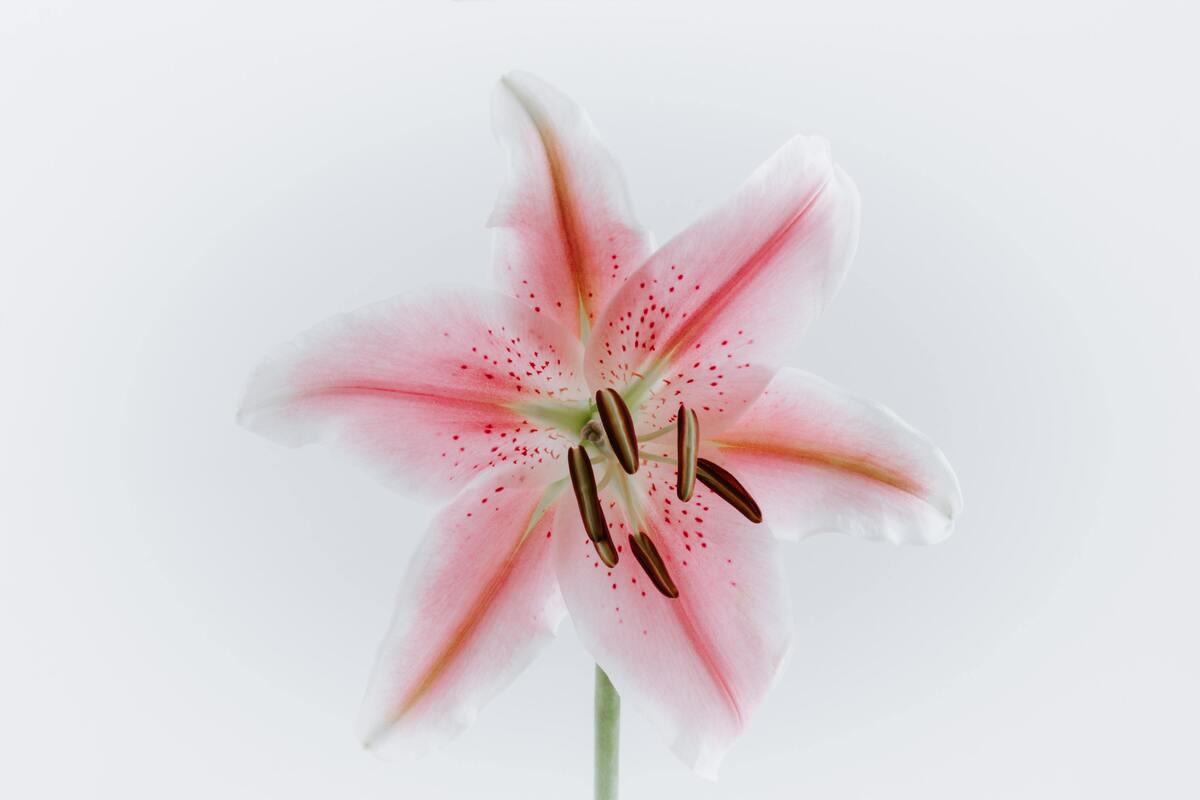Table of contents
What do you know about the Fleur-de-Lis symbol?

The fleur-de-lis was already the title of one of the most beautiful songs of Brazilian music and is known as a decorative flower and full of symbols. Added to this, the fleur-de-lis carries a monarchical heritage for having been widely used in European nations, especially in France at the time of kings and queens.
In addition, those who know the fleur-de-lis usually know that it carries a symbolism of honor, strength and loyalty. Similar to a lily, the fleur-de-lis is also widely used as coats of arms and by scouts. But, of course, that's not all that sums up the meaning of the fleur-de-lis, come learn more below!
Understanding more about the fleur-de-lis

Who sees the beautiful fleur-de-lis with its three upper tips separated, raised, powerful and the three lower tips united, merged and vibrant tone is often lost in its beauty. After all, the fleur-de-lis is one of the most beautiful plants to be admired, having its outlines transformed into tattoos, coats of arms, monarchical symbols, among others.
But to understand more about the fleur-de-lis is necessary to know its origin, alternative derivations, symbolic meaning, its use in antiquities, its image and the like. Come check below each time more of this flower full of potential!
Source
The fleur-de-lis for many resembles the beautiful lilies that decorate gardens, the flower is even considered a species of Iris pseudacorus and Iris florentina only in a more stylized version of the species.
In ancient times, the fleur-de-lis was found in the rooms of monarchs, and there are records that the presence of these flowers was because they surrounded the French and the Franks in the rivers they frequented before entering Gaul.
From this, it is understood that the kings in search of building an image of familiarity and beauty as a symbol, chose the well-known lilies that filled the houses of the regions.
Alternative derivations
Despite evidence that it was the fleur-de-lis used as a symbol of the French monarchy, some hypotheses are still debated about the other possible derivations, for example, it is still debated whether the symbol is not actually of a sting - a weapon widely used by the French.
It is also debated whether the monarchic inspiration did not come from the bees or doves descending from the heavens, as a representation of the Holy Spirit. However, in the end, the idea that it is the fleur-de-lis that represents the flags and coats of arms of the era of the kings and queens of such a region of Europe still prevails.
Meaning of the symbol
Signifying honour, strength, loyalty, purity of spirit, light and perfection; the fleur-de-lis symbol is much used in Scouting, and is even a world reference. This is because the petals of the fleur-de-lis, pointing northwards almost represents a compass rose; although these three points symbolise the Scout promises, specifically.
Also, like the tips that are well directed, the good Scout should always go forward and upward, amidst his purpose in life.
Ancient use and symbolism
Used at the coronation of King Clovis I, the first king of the Franks to unite all the Frankish tribes under one ruler, the fleur-de-lis symbol was also adopted as the royal coat of arms linked to divine symbolism, that is, the king linked directly to God. Therefore, the fleur-de-lis represents purity.
There was a rumour at the time that the oil used to anoint the king was made of fleur-de-lis and was sent directly from heaven to sanctify the monarch, just as it was also said that a fleur-de-lis adorned King Clovis I's helmet when he won his victory at the Battle of Vouillé.
Besides King Clovis I, other historical figures have been linked to the symbolism of the fleur-de-lis, such as King Louis who used the three petals of the flower representing faith, wisdom and chivalry. It is worth noting that the Virgin Mary who had wrapped around her image in many regions, the fleur-de-lis as a representation.
What does the image of the symbol look like?
The image of the fleur-de-lis symbol resembles a lily or a sting, formed by six points, the middle one being characterized by a point raised upwards and the two around it, points inclined downwards. The other ends are smaller and all directed downwards. In addition, the image symbol of the fleur-de-lis is usually in the tone of gold.
How to make the Fleur-de-Lis symbol?
To make the fleur-de-lis symbol is necessary to be inspired by the flowers of lilies, because they are similar in format and shape. So, set aside some time before and see some images of lilies on the internet, an interesting tip is to also look for the fleur-de-lis itself on google images instead of lilies, the inspiration will be even greater.
After that, you will need some material to help you make the contours, and thus build the six tips in a more harmonious way, a tip is to use the base of a glass because it is circular. Remember that each end has distinct extensions, being three tips directed up and three tips directed down.
From this it is worth noting that the middle tip is more voluminous and those around it are medium in volume, the three lower ones, directed downwards, are much smaller in length and width. If these instructions are followed, celebrate: you have succeeded in making the fleur-de-lis symbol.
Main symbolism of the fleur-de-lis

Rich in meanings and symbolism, the fleur-de-lis is present in religion, art, militarism, flags, sports, education, literature, architecture, scouting, fiction and in many tattoos around.
But, do you know the meanings that are behind each aspect of this? Come check below and stay on top of everything!
Religion and art
In many regions since ancient times, the fleur-de-lis was associated with Christian religious art, including representations of Christ were linked to this flower and similar flowers, such as lilies, since they carried the symbolism of purity and chastity.
It is no wonder that due to these last characteristics the fleur-de-lis was also linked to the Virgin and the Holy Trinity. Even in Notre Dame de Paris in centuries ago, images of Mary with the fleur-de-lis appeared on some cathedral coins and on some church seals.
Militarism
Beautiful, emblematic and striking fleur-de-lis are featured on military emblems in various regions such as in the United States that one of the units of the New Jersey Army National Guard has on the upper left side of its distinctive unit insignia a fleur-de-lis.
As well as US Army Cavalry Regiments, Medical Brigades, Infantry Brigade Combat Teams and the like, has as one of the symbologies in its symbol the fleur-de-lis. Also, as a legacy of the Vietnam War, the US Air Force Special Operations Weather Beret Flash used a fleur-de-lis in its design.
In the British Army, the fleur de lis was the emblem of the Manchester regiment for more than two decades. If you take a closer look at the history of several regions, you can find the fleur de lis as an emblem of several lines associated with militarism, reinforcing the power of this flower.
Flags
It is possible to identify representations of the fleur-de-lis in some coats of arms and flags, did you know that? The following are some examples of where to find such associations.
On French royal arms before 1376, French royal arms after 1376; on the flag of the French Renaissance; on the flag of the Kingdom of France; on the Naval flag of the Kingdom of France; on the flag of the Province of Lleida; on the flag of Quebec, also known as Fleurdelisé; French-American flag in New England; flag of Aroostook County in Maine.
In addition, there is also the flag of Acadiana; in the flag of the Franco-Albertensis; in the flag of the Franco-Trotarians; in the flag of Detroit; in the flag of New Orleans; in the old flag of Louisville, Kentucky; in the flag of St. Louis, Missouri; in the flag of Baton Rouge, Louisiana; in the flag of Montgomery County, Maryland; in the flag of Aguas de Lindóia, Brazil and finally, in the flagof Brejões, Brazil.
Sports
The fleur-de-lis is associated by several sports teams, when it comes to a local team flag then it is quite honoured as in the international teams of Quebec, Montreal Expos and CF Montréal.
Two curiosities are that Marc-André Fleury, a Canadian ice hockey goalie, has the image of the fleur-de-lis on his mask and France used the fleur-de-lis symbol on the official emblem at the FIFA Women's World Cup 2019. In Brazil, however, no association of this flower with sports is identified, until then.
Education
The fleur de lis with its symbolism and potency appears in some emblems, coats of arms and logos of international universities like the "University of Louisiana at Lafayette and Saint Louis University and Washington University in Missouri" and schools like Hilton College in South Africa; "St. Peter, Minnesota and Adamson University and St. Paul's University" in the Philippines.
In Monticello some schools and universities have also adopted the fleur-de-lis as one of the symbols associated with their coat of arms. The Lincolnshire flag has fleur-de-lis emblem, for example.
In addition, several fraternities in academies have adopted the fleur-de-lis as symbols such as the fraternity "Kappa Kappa Gamma and Theta Phi Alpha, the American fraternities Alpha Epsilon Pi, Sigma Alpha Epsilon and Sigma Alpha Mu," and finally the international fraternity "Alpha Phi Omega."
Literature
The fleur-de-lis is present in great works such as "The Da Vinci Code" by Dan Brown, "The Hunchback of Notre Dame", by Victor Hugo and "The Three Musketeers" by Alexandre Dumas. In the Literature course the fleur-de-lis symbolizes the analogy between three spheres: linguistics, literature and grammar, symbolized by each petal of the flower.
Thus, the petal on the left refers to linguistics, the petal in the middle represents literature and the petal on the right represents grammar. It is worth noting that below the bundle that unites them, they follow, symbolizing their continuity.
Architecture
In architecture, the fleur-de-lis is used as a tool representing defense, as its structure is often placed on top of iron fence posts.
In addition, the fleur-de-lis can be incorporated into friezes and cornices and are widely used to embellish tiles in any room of the house. Furthermore, in some English churches the fleur-de-lis design has been incorporated into coats of arms and is a cause for praise to this day.
Scouting
The symbol of the fleur-de-lis associated with Scouting was defined by Robert Baden-Powell as representing the movement that he wanted, that is, the direction that Scouting would follow from then on: upwards and forwards, always.
Soon, in the Scout movement, the three petals represent the three pillars of the Scout promise and the pointing to North on maps and compasses shows where the young person should go.
Fiction
The symbol has appeared in modern fiction on historical and mystical themes, such as in the best-selling novel The Da Vinci Code and other books discussing the Priory of Sion, plus a variation of the symbol was also used in the Star Wars franchise to represent the planet Naboo.
The fleur de lis is also used as the heraldic emblem of the Kingdom of Temeria in Andrzej Sapkowski's fantasy novel series, The Witcher.
Finally, the fleur-de-lis was used in the TV series The Originals, in which it is used to represent the Mikaelson family, the world's first vampires. But despite these few examples, there are countless representations of the fleur-de-lis in television and fictional series.
Tattoo
The fleur-de-lis just by being rich in beauty is associated with meanings of honor, strength, loyalty, purity of spirit, light and perfection; it is easily eternalized on the skins of people in different corners of the world.
Also, a curious fact tied to fleur-de-lis with tattoos is that after Hurricane Katrina, many New Orleanians, were tattooed with "one of their cultural emblems" in order to create a memorial, according to a researcher at Tulane University.
National symbolism of the fleur-de-lis

Did you know that in different places around the world the fleur-de-lis has a specific symbolism? Come check its specificities in France, the United States, Brazil, the United Kingdom, Canada, Albania, Bosnia and Herzegovina and other countries and municipalities below!
France
Although the fleur-de-lis has appeared on many European coats of arms and flags over the centuries, it is especially associated with the French monarchy in a historical context and remains a potent symbol of France appearing on French postage stamps, although it has never been officially adopted by any of the French republics.
In addition, to this day the fleur-de-lis is widely used in emblems of French cities, as in the coat of arms of the city of Lille, Saint-Denis, Brest, Clermont-Ferrand and Calais. Thus, the fleur-de-lis was the symbol of the Île-de-France, the core of the French kingdom and many of today's French departments use the symbol on their coats of arms to manifest this tradition.
United States
Fleur-de-lis crossed the Atlantic along with Europeans going to the New World, especially with French settlers. Their presence on North American flags and coats of arms can be associated with the involvement of French settlers in the history of the city or region in question and, in some cases, the persistent presence of a population descended from those settlers.
Currently some of the places that have it on their flag or seal are the cities of Baton Rouge, Detroit, Lafayette, Louisville, Mobile, New Orleans, Ocean Springs and St. Louis; being that in 2008, the governor of Louisiana, Bobby Jindal, sanctioned a bill that makes the fleur de lis an official state symbol.
Brazil
In Brazil, the city of Joinville in Santa Catarina, has three fleur-de-lis topped with a three-pointed tag on its flag and coat of arms.
It is also very present in the Scout groups of the region, such as the Order of the Fleur de Lis, which is a reserve and capitalization fund of the Scout Movement, created to contribute directly to the preservation of the Brazilian Scouting, according to the official website of the Scouts of Brazil.
United Kingdom
In relation to the fleur-de-lis with the United Kingdom there are few things, but there are some curiosities, as for example a fleur-de-lis appeared on the official coats of arms of the Norroy King of Arms for many years, and a fleur-de-lis characterized the blue background of the arms of the Digby Barons.
Canada
In Canada the fleur-de-lis has as one of its main associations the country's coat of arms which was proclaimed by King George V on November 21, 1921, as the arms or armorial insignia of the dominion of Canada.
Albania
In Albania, the fleur-de-lis has always been associated with the Noble House of Topia. There is a well-known story that Andrea Topia, a 15th century Albanian nobleman, fell in love with the daughter of Roberto of Naples when his ship stopped in Durazzo, where they met.
Andrea therefore abducted and married her, and the two had two sons, Karl and George. However, the couple was executed and their son upon assuming the throne wore the fleur-de-lis as a symbol representing the royal blood of his family, traced to his father's tragic deaths. However, after the Ottoman conquest of Albania, the symbol was removed.
Bosnia and Herzegovina
The coat of arms of the medieval kingdom of Bosnia contained six fleur-de-lis, known as the Bosnian native. As such, this emblem was reused in 1992 as a national symbol of the Republic of Bosnia and Herzegovina and was the flag of Bosnia and Herzegovina from 1992 to 1998, however the state insignia was changed in 1999.
The fleur-de-lis also appears on the flags and coats of arms of many cantons, municipalities, cities and towns. To this day, it is even used as the official insignia of the Bosnian Regiment of the Armed Forces of Bosnia and Herzegovina
Other countries and municipalities
Some other curiosities of the fleur-de-lis is that it appears on the clothing of Guadeloupe, an overseas department of France in the Caribbean and St. Bartholomew, an overseas collectivity of France and French Guiana. In addition, the overseas department of Reunion in the Indian Ocean uses the same symbol of the fleur-de-lis as a representation.
In short, the fleur-de-lis also appears on the coat of arms of Port Louis, capital of Mauritius, which was named after King Louis XV. On the coat of arms of Saint Lucia, it represents the country's French heritage, among other tributes and representations.
The Fleur-de-Lis is at once religious, political, artistic and more!

The fleur-de-lis is certainly a religious, political and artistic plant. This is because, for those who do not know, the fleur-de-lis is also assimilated to the sun's rays and traditionally, the liturgy associated Christ with the sun or light, and royalty was always linked to solar symbolism. Once again, the link between royalty and the Christian religion exists.
And in art, whether in music, films, plays and the like, the fleur-de-lis is always used as a symbol of beauty

